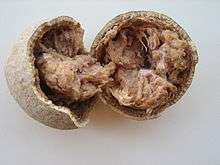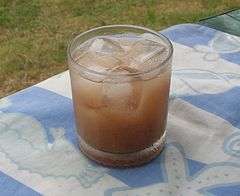Limonia acidissima
| Limonia acidissima | |
|---|---|
 | |
| Scientific classification | |
| Kingdom: | Plantae |
| (unranked): | Angiosperms |
| (unranked): | Eudicots |
| (unranked): | Rosids |
| Order: | Sapindales |
| Family: | Rutaceae |
| Subfamily: | Aurantioideae |
| Tribe: | Citreae |
| Genus: | Limonia L. |
| Species: | L. acidissima |
| Binomial name | |
| Limonia acidissima L. | |
| Synonyms[1][2] | |
| |
Limonia acidissima is the only species within the monotypic genus Limonia. It is native from China to the Indian Subcontinent and eastwards to Southeast Asia. It is also native to the Dominican Republic.[3] Common names for the species in English include wood-apple and elephant-apple.[3] It is reputed for its medicinal properties.[4]
Description
Limonia acidissima is a large tree growing to 9 metres (30 ft) tall, with rough, spiny bark. The leaves are pinnate, with 5-7 leaflets, each leaflet 25–35 mm long and 10–20 mm broad, with a citrus-scent when crushed. The fruit is a berry 5–9 cm diameter, and may be sweet or sour. It has a very hard rind which can be difficult to crack open, and contains sticky brown pulp and small white seeds. The fruit looks similar in appearance to the Bael fruit (Aegle marmelos).
Wood-apple tree in Trincomalee, Sri Lanka |
 A glass of woodapple juice |
Taxonomy
A number of other species formerly included in the genus are now treated in the related genera Atalantia, Citropsis, Citrus, Glycosmis, Luvunga, Murraya, Microcitrus, Micromelum, Naringi, Pamburus, Pleiospermium, Severinia, Skimmia, Swinglea, and Triphasia.[5]
Uses
The fruit is used to make a fruit juice with astringent properties and jams. Its leaves also have medicinal properties and are considered auspicious to be offered to Lord Shiva in pujas. A majority of Hindu temples will have a sacred tree within its compound and is known as the sthala vriksha.
References
- ↑ "The Plant List: A Working List of All Plant Species". Retrieved 1 August 2015.
- ↑ B. C. Stone, D. H. Nicolson (November 1978). "Arguments for Limonia acidissima L. (Rutaceae) and against Its Rejection as a nomen ambiguum". 27. Taxon: 551–552. JSTOR 1219924. Retrieved 2011-04-19.
- 1 2 "Limonia acidissima". Germplasm Resources Information Network (GRIN). Agricultural Research Service (ARS), United States Department of Agriculture (USDA). Retrieved 2016-04-03.
- ↑ Health Benefits of Wood Apple or Bel Fruit
- ↑ John H. Wiersema (2005-02-22). "Species in GRIN for genus". Ars-grin.gov. Retrieved 2011-04-19.
External links
| Wikimedia Commons has media related to Limonia acidissima. |